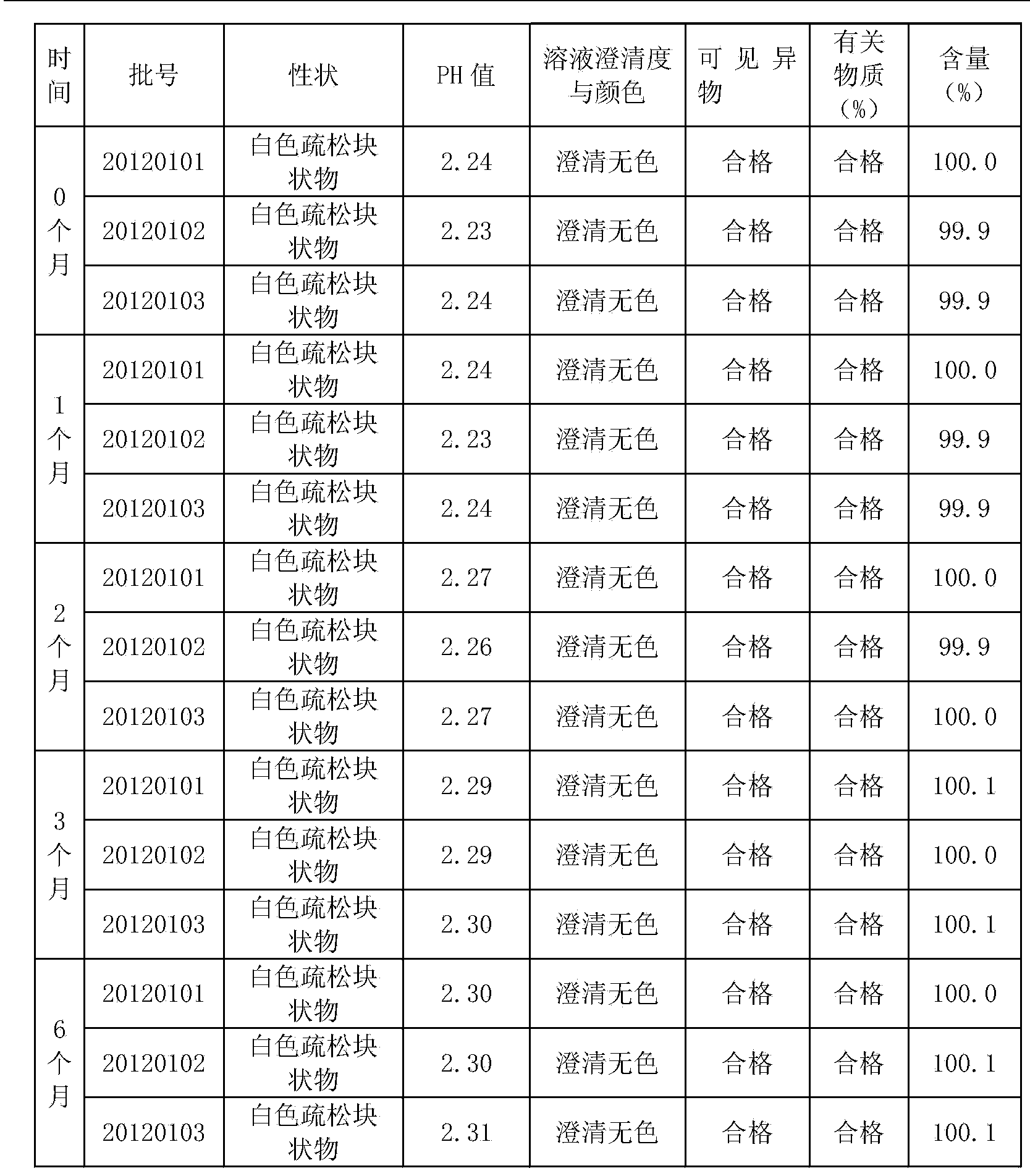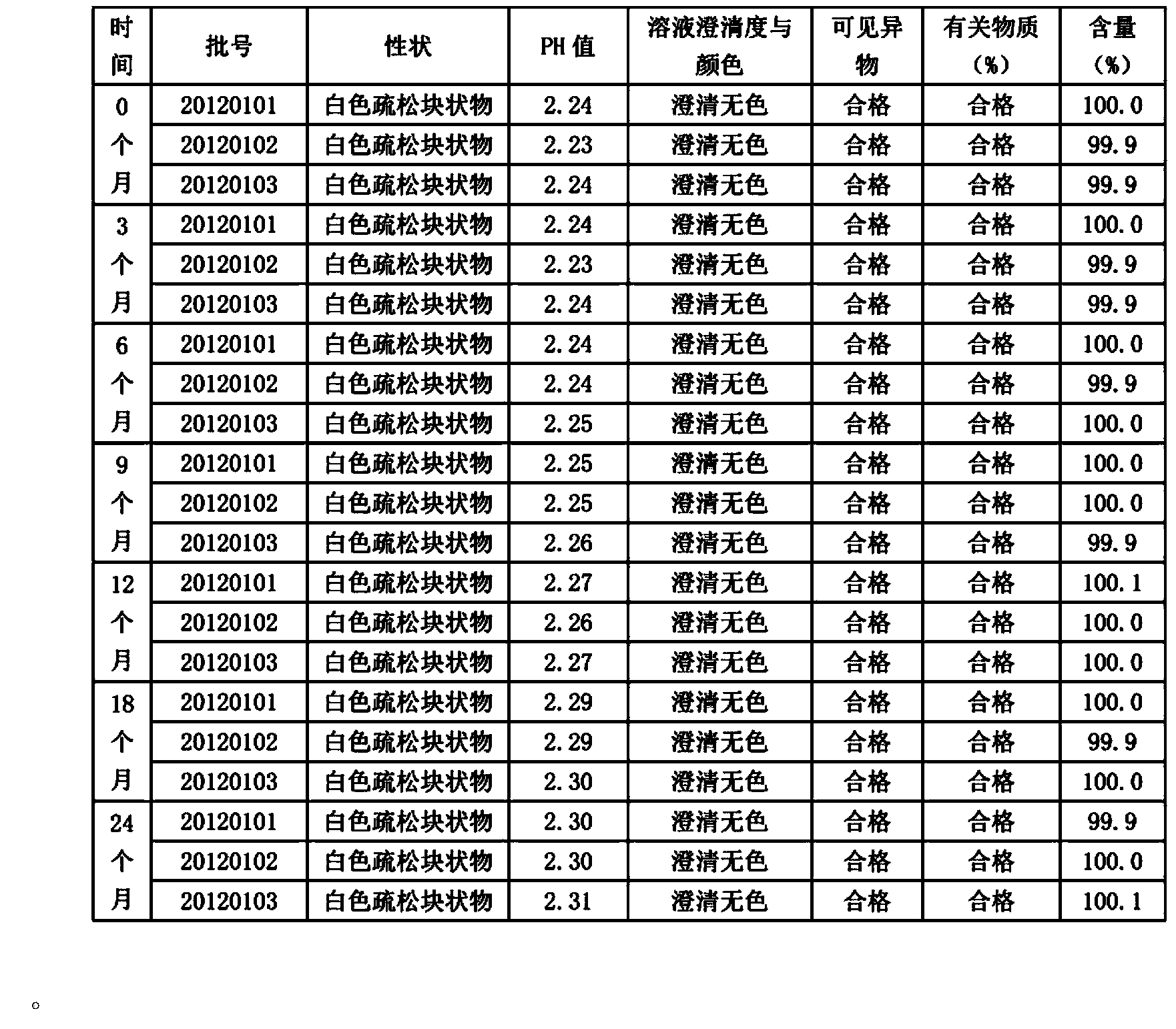Special ultrafine tiopronin powder lyophilized preparation and preparation method thereof
An ultra-fine powder, tiopronin technology, applied in the field of medicine, can solve the problems of low clarity of tiopronin, small specific surface area, large toxic and side effects, etc. Effect
- Summary
- Abstract
- Description
- Claims
- Application Information
AI Technical Summary
Problems solved by technology
Method used
Image
Examples
Embodiment 1
[0022] Add 163 grams (1.5 mol) of 2-chloropropionic acid and 68.7 grams (0.5 mol) of phosphorus trichloride to a dry 500ml reaction bottle, stir and react under the condition of blocking moisture, and react for 4 hours at a reaction temperature of 40°C to generate 2 - Chloropropionyl chloride. After the reaction was finished, the distillate at 107-113° C. was collected by distillation to obtain 181 grams of 2-chloropropionyl chloride as a colorless liquid, with a yield of 95%. Add 37.5 g (0.5 mol) of glycine, 26.5 g (0.25 mol) of anhydrous sodium carbonate and 250 ml of water to a 1000 ml reaction bottle, stir to dissolve. Cool in an ice-salt bath, add 63.5 g (0.5 mol) of 2-chloropropionyl chloride dropwise under vigorous stirring, and control the reaction temperature at -5°C. At the same time, add a saturated solution of anhydrous sodium carbonate to make the reaction solution weakly alkaline. After the addition was complete, the stirring reaction was continued for 3 hours. ...
Embodiment 2
[0030]Add 163 grams (1.5 mol) of 2-chloropropionic acid and 68.7 grams (0.5 mol) of phosphorus trichloride to a dry 500ml reaction bottle, stir and react under the condition of blocking moisture, and react at a reaction temperature of 45°C for 3.5 hours to generate 2 - Chloropropionyl chloride. After the reaction, the distillate at 107-113° C. was collected by distillation to obtain 183 grams of 2-chloropropionyl chloride as a colorless liquid, with a yield of 96.1%. Add 37.5 g (0.5 mol) of glycine, 26.5 g (0.25 mol) of anhydrous sodium carbonate and 250 ml of water to a 1000 ml reaction bottle, stir to dissolve. Cool in an ice-salt bath, add 63.5 g (0.5 mol) of 2-chloropropionyl chloride dropwise under vigorous stirring, and control the reaction temperature at -10°C. At the same time, add a saturated solution of anhydrous sodium carbonate to make the reaction solution weakly alkaline. After the addition was complete, the stirring reaction was continued for 4 hours. After th...
Embodiment 3
[0038] Add 163 grams (1.5 mol) of 2-chloropropionic acid and 68.7 grams (0.5 mol) of phosphorus trichloride to a dry 500ml reaction bottle, stir and react under the condition of blocking moisture, and react at a reaction temperature of 50°C for 3 hours to generate 2 - Chloropropionyl chloride. After the reaction, the distillate at 107-113° C. was collected by distillation to obtain 182 grams of 2-chloropropionyl chloride as a colorless liquid, with a yield of 95.6%. Add 37.5 g (0.5 mol) of glycine, 26.5 g (0.25 mol) of anhydrous sodium carbonate and 250 ml of water to a 1000 ml reaction bottle, stir to dissolve. Cool in an ice-salt bath, add 63.5 g (0.5 mol) of 2-chloropropionyl chloride dropwise under vigorous stirring, and control the reaction temperature at -15°C. At the same time, add a saturated solution of anhydrous sodium carbonate to make the reaction solution weakly alkaline. After the addition was complete, the stirring reaction was continued for 5 hours. After the...
PUM
| Property | Measurement | Unit |
|---|---|---|
| Diameter | aaaaa | aaaaa |
| Diameter | aaaaa | aaaaa |
| Diameter | aaaaa | aaaaa |
Abstract
Description
Claims
Application Information
 Login to View More
Login to View More - R&D
- Intellectual Property
- Life Sciences
- Materials
- Tech Scout
- Unparalleled Data Quality
- Higher Quality Content
- 60% Fewer Hallucinations
Browse by: Latest US Patents, China's latest patents, Technical Efficacy Thesaurus, Application Domain, Technology Topic, Popular Technical Reports.
© 2025 PatSnap. All rights reserved.Legal|Privacy policy|Modern Slavery Act Transparency Statement|Sitemap|About US| Contact US: help@patsnap.com


